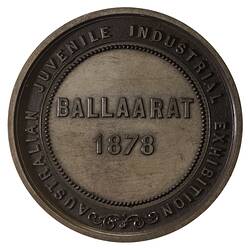Summary
Australia Victoria Ballarat
Ballarat Juvenile Industrial Exhibition Bronmze Prize Medal 1878 (AD)
Awarded to: Not issued
Un-issued bronze prize medal struck for the Australian Industrial Exhibition of 1878 held in Ballarat. The Ballarat Juvenile Industrial Exhibition was held to encourage young people to compete in 'works of industry and usefulness', to impress the dignity and honour of labour, to nurture those in the trades, to show handiwork, to share ideas, to develop the idea of 'useful employment' in leisure hours and to create a 'taste for the fine arts and ornamental works, so as to make the home attractive'. People under the age of 21, of both sexes, were invited to participate. Parents, employers and teachers were asked to enourage participation. The Patron of the Exhibition was Sir George Bowen, KCMG, Governor of Victoria. The Exhibition was intended to be inter-colonial, but only New Zealand 'entered the competition with spirit'. It opened on 15 February 1878 in the Alfred Hall, the market sheds and adjoining grounds. A total of 5105 exhibits were mounted. Entry categories included furniture, boots and shoes, brassware and tinware, agricultural implements, processed foods, handcrafts and art, maps and plans, shorthand and writing, photography and jewellery. The Alfred Hall was decorated for the opening ceremony with tree ferns and a fountain resembling a volcano. The dais was covered with crimson carpet, contrasting with green and gold chairs. A choir sang 'God Save the Queen', the Governor was cheered, and speeches were made. The Governor declared the Exhibition open, then repaired to a grand banquet. Daily entry to the Exhibition cost 1s for adults and 6d for children, with some days more expensive; season tickets were also available. Promenade concerts were held each evening. No gold medals were awarded for the exhibits, which caused some discontent in the media, but the Committee argued that no entrant had deserved a gold medal (in spite of generous praise in the Official Catalogue). 205 silver and 172 bronze medals were awarded, as well as 444 first class certificates, 230 second class and 52 third class. A full list of medal-winners was published in the Courier, Star and Evening Post. The total cost of medals and certificates was 412 pounds 10s. The exhibition closed on 1 June. It had attracted 159,500 visitors, with total takings of 4,466 pounds.
Physical Description
An unissued specimen of the Bronze Prize medal (47 mm diameter) of the Ballaarat exhibition of 1878. It features Industry crowning a young entrant, who kneels and holds a railway steam engine, with a victor's wreath.
Obverse Description
Industry standing facing left crowning a young entrant, who kneels right and holds a railway steam engine, with a victor's wreath; in exergue, INDUSTRIA and in small letters the artist's name, ALTMANN MELBOURNE
Reverse Description
At centre within a broad rim, BALLAARAT 1878; around on broad rim, AUSTRALIAN JUVENILE INDUSTRIAL EXHIBITION
Edge Description
Plain
Significance
The Ballarat Juvenile Industrial Exhibition was held to encourage young people to compete in 'works of industry and usefulness', to impress the dignity and honour of labour, to nurture those in the trades, to show handiwork, to share ideas, to develop the idea of 'useful employment' in leisure hours and to create a 'taste for the fine arts and ornamental works, so as to make the home attractive'. People under the age of 21, of both sexes, were invited to participate. Parents, employers and teachers were asked to enourage participation. The Patron of the Exhibition was Sir George Bowen, KCMG, Governor of Victoria. The Exhibition was intended to be inter-colonial, but only New Zealand 'entered the competition with spirit'. It opened on 15 February 1878 in the Alfred Hall, the market sheds and adjoining grounds. A total of 5105 exhibits were mounted. Entry categories included furniture, boots and shoes, brassware and tinware, agricultural implements, processed foods, handcrafts and art, maps and plans, shorthand and writing, photography and jewellery. The Alfred Hall was decorated for the opening ceremony with tree ferns and a fountain resembling a volcano. The dais was covered with crimson carpet, contrasting with green and gold chairs. A choir sang 'God Save the Queen', the Governor was cheered, and speeches were made. The Governor declared the Exhibition open, then repaired to a grand banquet. Daily entry to the Exhibition cost 1s for adults and 6d for children, with some days more expensive; season tickets were also available. Promenade concerts were held each evening. No gold medals were awarded for the exhibits, which caused some discontent in the media, but the Committee argued that no entrant had deserved a gold medal (in spite of generous praise in the Official Catalogue). 205 silver and 172 bronze medals were awarded, as well as 444 first class certificates, 230 second class and 52 third class. A full list of medal-winners was published in the Courier, Star and Evening Post. The total cost of medals and certificates was 412 pounds 10s. The exhibition closed on 1 June. It had attracted 159,500 visitors, with total takings of 4,466 pounds.
More Information
-
Collecting Areas
-
Acquisition Information
Transfer from Melbourne Branch of Royal Mint, 1978
-
Date Issued
1878 AD
-
Issued By
-
Artist
Ernst August Altmann, Melbourne, Greater Melbourne, Victoria, Australia, 1878
-
Inscriptions
Obverse: INDUSTRIA and in small letters the artist's name, ALTMANN MELBOURNE Reverse: AUSTRALIAN JUVENILE INDUSTRIAL EXHIBITION BALLAARAT 1878
-
Series
-
Material
Bronze
-
Axis
12
-
Classification
-
Category
-
Discipline
-
Type of item
-
Dimensions
47 mm (Outside Diameter), 55.43 g (Weight)
-
Shape
Round
-
References
Car.1878/1 Official Record, Containing Introduction, Inaugural Ceremonies, General Notes, etc, by Charles J. Richardson, Corresponding Secretary (State Library of Victoria Rare Books).
-
Keywords



